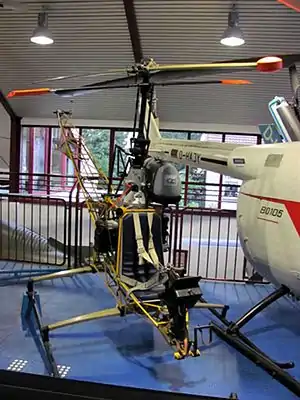Bölkow Bo 103
The Bölkow Bo 103 was a small experimental helicopter flown in West Germany in 1961 to research new rotor systems. While the mechanics of the aircraft were based on the Bo 102 captive training rig, the Bo 103 was capable of fully independent flight. In configuration, it was absolutely minimalist - consisting of nothing more than a tubular frame to which the dynamic components and the pilots seat were attached, although a small fibreglass cabin was eventually attached. The aircraft retained the Bo 102's single-rotor of Glass-reinforced plastic, and proved that this was suitable for true flight. The prototype is preserved at the Hubschraubermuseum Bückeburg.
| Bo 103 | |
|---|---|
 | |
| Bölkow Bo 103 at Hubschraubermuseum Bueckeburg | |
| Role | Experimental helicopter |
| National origin | West Germany |
| Manufacturer | Bölkow |
| First flight | 14 September 1961 [1] |
| Number built | 1 |
Specifications
General characteristics
- Crew: 1
- Height: 2.41 m (7 ft 11 in)
- Empty weight: 268 kg (591 lb)
- Gross weight: 390 kg (860 lb)
- Powerplant: 1 × Agusta GA.70 4-cylinder air-cooled horizontally-opposed piston engine, 61 kW (82 hp)
- Main rotor diameter: 6.66 m (21 ft 10 in)
- Main rotor area: 34.8 m2 (375 sq ft) single bladed counter-balanced rotor
Performance
- Maximum speed: 100 km/h (62 mph, 54 kn)
- Range: 100 km (62 mi, 54 nmi)
- Rate of climb: 5.7 m/s (1,120 ft/min)
References
- Taylor, Michael J. H. (1989). Jane's Encyclopedia of Aviation. London: Studio Editions. p. 192.
- Simpson, R. W. (1998). Airlife's Helicopters and Rotorcraft. Ramsbury: Airlife Publishing. p. 131.
- EADS website
External links
| Wikimedia Commons has media related to Bölkow Bo 103. |
- picture at Bückeburg helicopter museum.
This article is issued from Wikipedia. The text is licensed under Creative Commons - Attribution - Sharealike. Additional terms may apply for the media files.
